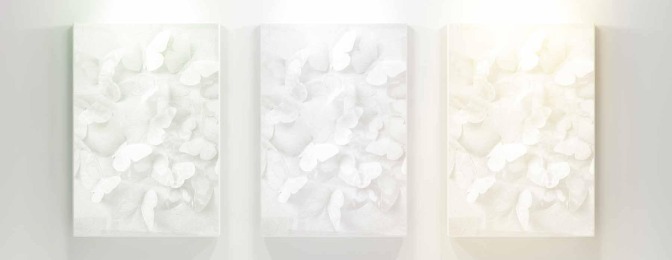Osram claims to have solved an issue with white light perception that has confounded lighting designers for 85 years. White LEDs can have exactly the same color coordinates within the CIE 1931 2-degree xy color diagram, but can look different to an observer.

According to Osram, this problem is caused by inaccuracies in the CIE 1931 2° xy color diagram that manufacturers use for LED white binning.

These three white spot lights have the same xy color coordinates but appear slightly different in color.
LEDs with different spectral compositions may be measured with exactly the same color coordinates. However, human visual perception still reveals color differences. Osram says that different light converter compositions or different wavelengths of the blue chip can cause these spectral differences. Osram further claims to have devised a solution to this issue of human visual perception. The company created what they call ten-degree binning that applies the recent CIE 170-2:2015 technical report to LED binning.
The report employs the latest about cone optical nerves from 2006 to create a fundamental chromaticity diagram with physiological axes. The fundamental chromaticity diagram with physiological axes can ensure that the visible color differences are captured in binning and measurement. Osram says that its new TENº binning uses three new steps in the white binning of LEDs to ensure that a 3SDCM binning only shows up to 3UNIT real color differences and not more. Using the latest fundamental color matching functions instead of the CIE 1931 ensures the proper measurement of the color coordinates in a color diagram with physiologically significant axes.

Osram notes that switching from the 2° to the 10° field of view allows a much closer measurement match and color difference assessment in real-world general lighting applications. The 2° is roughly a 20mm disc at 0 and 5m. However, the 10° field of view is equivalent to a 90mm disc at 0 and 5m and therefore much closer to most real life situations.
The MacAdam ellipses of the xy scale are transformed to a circles in a u’v’ scale within a unified color space in which color differences in all directions are equally scaled. This transformation apparently makes it much easier to determine if the color differences measured are equivalent to the visual (perceptual) color differences in all directions.
In certain cases, when these same LEDs are measured in the 2015 10° color space, the color differences can be even more than 3UNITs. For this reason, Osram says that TEN° binned LEDs fall safely within the 3UNITs boundary and don’t lead to this kind of unpleasant surprises. The new TEN° Binning will completely comply with the existing 1931 2° standard 3SDCM binning. However, the new 2015° 10° 3UNIT feature better protects against unexpectedly large color differences.





